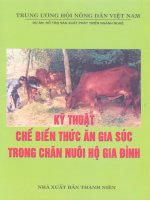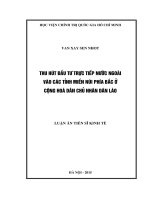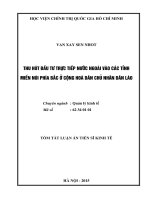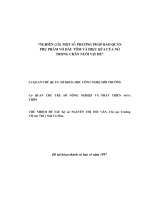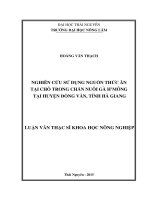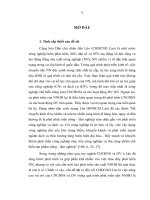Phụ phẩm từ sắn là nguồn thức ăn tiềm năng trong chăn nuôi bò ở cộng hoà dân chủ nhân dân lào
Bạn đang xem bản rút gọn của tài liệu. Xem và tải ngay bản đầy đủ của tài liệu tại đây (1.75 MB, 122 trang )
HUE UNIVERSITY
UNIVERSITY OF AGRICULTURE AND FORESTRY
PHANTHAVONG VONGSAMPHANH
CASSAVA BY-PRODUCT AS POTENTIAL FEED SOURCE
FOR YELLOW CATTLE IN LAO PDR
DOCTOR OF PHILOSOPHY IN ANIMAL SCIENCES
HUE, 2019
HUE UNIVERSITY
UNIVERSITY OF AGRICULTURE AND FORESTRY
PHANTHAVONG VONGSAMPHANH
CASSAVA BY-PRODUCT AS POTENTIAL FEED SOURCE
FOR YELLOW CATTLE IN LAO PDR
SPECIALIZATION: ANIMAL SCIENCES
CODE: 9620105
DOCTOR OF PHILOSOPHY IN ANIMAL SCIENCES
SUPERVISOR 1: ASSOCIATE PROFESSOR. DR. NGUYEN XUAN BA
SUPERVISOR 2: DR. DINH VAN DUNG
HUE, 2019
2
GUARANTEE
I hereby declare that this dissertation is the result of my work and that is has not
been presented previously as a dissertation at this university or elsewhere. To declare
that all sources to be acknowledged and all to be listed in the reference.
Hue University, 2019
Phanthavong Vongsamphanh, PhD student
3
ACKNOWLEDGEMENTS
I would like to express my sincere gratitude and appreciation to my major
advisor, Associate Professor Dr. Nguyen Xuan Ba, Faculty of Animal Science and
Veterinary Medicine, Hue University of Agriculture and Forestry, Hue University, Hue
City, Vietnam for his invaluable advice, encouragement and generous sharing of
knowledge both scientifically and actually, which has enabled me to complete this
thesis.
I would like also deeply grateful to my co-advisors, Dr. Dinh Van Dung, Faculty
of Animal Science and Veterinary Medicine, Hue University of Agriculture and
Forestry, Hue University, Hue City, Vietnam for his kind not only served as my coadvisor, but has been a friend, encouraging me to explore and experience to the limit.
He has provided so many valuable services beyond just advising, teaching, mentoring
and continuous support in many ways to broaden my perspectives and made this thesis
the final product of my research.
I would like to express my sincere thanks to Professor Dr. T R Preston from
Centro para la Investigación en Sistemas Sostenibles de Producción Agropecuaria
(CIPAV), Carrera 25 No 6-62 Cali, Colombia for his advice, suggestions and guided in
my experiment from the beginning and made correction as needed, include revision of
English in the manuscript. His encouragement, criticism, excellent technical assistance
guided not only my study but also invaluable suggestions for me in the future.
My research and education would not have been possible without Dr
Viengsakoun Napasirth from Faculty of Agriculture, National University of Lao and the
Faculty of Agriculture and Forest Resource, Souphanouvong University and my friend
there’s. Mr. Sangkhom Inthapanya and Mr. Phonevilay Silivong for their provided
valuable help in the laboratory. I also would like to thanks to Mr. Khamla and Mr.
Vakili Vongxay, owners of the Sukanya and Natthanasouck farms where the
experiments were carried out, for providing access to cattle, feed resources and
infrastructure.The Tropical Feed Resources Research and Development Center
(TROFEC) of Khon Kaen University, Thailand is acknowledged for support in
collection of rumen samples and VFA analysis.
4
Thanks to Department of Livestock and Fisheries, National Agriculture and
Forestry Research Institute, Ministry of Agriculture and Forestry for facilities supported
and permission for me to study. I wish to express my sincere appreciation to all those
people whose names do not appear here-in who helped me to complete this thesis. I
would like to give big thanks to my family for their understanding and moral support
during the study, especially my wife for her encouragement and inspiration.
Finally, I wish to express special thanks to the MEKARN Project II for
generous contribution towards financial support that made this thesis, my education and
career goals possible.
5
ABSTRACT
The objectives of this study were (i) evaluated the potential of feeding value of
the cassava pulp to local yellow cattle. (ii) to study the effect of brewers' grain and
cassava foliage (Manihot esculenta Cranz) as protein sources for Lao local cattle fed
cassava pulp-urea as basal diet, (iii) to evaluate the effects of source of cassava leaves
(sweet or bitter at 4% DM) and with or without of brewers’ grain at 4% DM in an in
vitro rumen fermentation on gas and methane production using the ensiled cassava pulp
supplemented with urea as basal substrate (iv) to evaluated the basis of the method for
incorporating cassava foliage as the protein-fiber source in a fattening system for local
Yellow cattle based on ensiled cassava pulp (derived from processing of cassava roots
for starch production).
The result of first experiment were the pH was changed with the level of pit
depth the pH was high when collected sample in surface and pH decreased when
collected deeper and DM was between 20 to 25%. Gas production and DM
mineralization values after 24h fermentation in an in vitro incubation showed cassava
pulp was slightly inferior (<10%) to fresh cassava root as an energy feed resource for
ruminants. Local "Yellow" cattle fed ad libitum ensiled cassava pulp, urea, brewers'
grains and rice straw was gain averaged 0.66 kg/day after 4 months of fattening, with a
DM feed conversion of 6.67, confirming that ensiled cassava pulp could be the basal
diet for intensive fattening of cattle in Lao PDR.
For the second experiment found that live weight gains were 517 and 495g/d
and DM feed conversions were similar for the diets in which all the protein came from
brewers’ grains (BG) or when the source of protein was divided equally between
brewers’ grains and bitter cassava foliage (CF-BG) (7.55 and 8.05). DM feed intake
was reduced by 30% and growth rate very poor (160 g/d) when bitter cassava foliage
was the only source of protein. The third experiment the rate of gas production was
higher when leaves of sweet rather than bitter cassava were the source of protein and
when brewers’ grains were added to the substrate. For all incubation intervals the
methane content in the gas was lower for bitter than for sweet cassava leaves and lower
when brewers’ grains were added to the substrate. The proportion of substrate DM that
6
was digested and the methane produced per unit DM digested were reduced when the
leaves of bitter rather than sweet cassava were the source of protein. The effect of the
brewers’ grains was to increase the proportion of DM digested and to reduce the
methane production per unit of substrate digested. And the last experiment found that
growth rates were 622 and 608 g/day when the diet of ensiled cassava pulp,
supplemented with urea, cassava foliage, brewers’ grains and rice straw, was fed as a
completely mixed ration in fresh form (CMR), or after ensiling for 21 days (ECMR).
Live weight gains were 30% higher (857 g/day) when almost all the protein was in the
form of brewers’ grains, and the ingredients were not mixed (apart from the urea which
was dissolved in the cassava pulp at the time of feeding). Feed conversion rates were
8.85 and 9.14 for the CMR and ECMR systems compared with 6.61 for the control. It
is suggested that excessively high levels of cyanogenic glucosides in the cassava
foliage, which was collected at the end of the dry season from a “bitter” cassava variety
at the time of root harvest, may have contributed to the poorer performance of the cattle
fed the CMR diets. The result indicated that using cassava by-product to cattle fattening
for energy and protein sources promoted weigh gain of cattle.
TABLE OF CONTENTS
7
LIST OF TABLES
8
TABLE OF FIGURE
9
INTRODUCTION
1. PROBLEM STATEMENT
According to the MAF (2017), there are 1.98 million cattle in Lao PDR mostly
dominated by indigenous "Yellow" cattle (Bos indicus). 95% of the total cattle
population is owned by smallholders. 297,000 of farm households or 38% of the total
farm household have cattle. Approximately 27% of total farm households in the
northern region hold cattle, while in central and southern regions the percentage of
households having cattle were 50% and 32% of total farm households, respectively
(ACO 2012).
Cattle production in Lao PDR is an interplay of human and natural systems
performing critical development functions through its contribution to nutritious diets,
economic growth, livelihoods and environmental sustainability. Cattle production is an
integral part of the smallholder mixed farming systems practiced in the country and can
be characterized by agro-ecological conditions of lowlands, uplands, and highlands,
where farmers utilize various land resources for cattle grazing. The majority of the
cattle production is based on low input integrated with various types of crop production
systems at the household level. Many rural households with cattle are currently best
considered to be “livestock keepers” rather than “livestock producers".
The main problem with cattle production in Lao PDR is nutrient deficiency,
particularly during the long dry season (see figure in appendix 1-4). Fiems et al (2015)
indicating that beef cattle feeding systems that do not meet the energy requirements of
the animals may result in the failure of beef cattle to meet performance expectations.
Poor grazing and dry season management in beef cattle in Lao PDR resulting in low
reproductive performance with calving rate around 51-75% calving interval 14-16
months, time to reach slaughter weight for males 5-8 years and low beef cattle carcass
weights of 65- 84 kg, with dressing percentages well below profitable levels (i.e. less
than 40%) (Nampanya et al., 2013).
Currently, there is an increasing surplus of cassava by-product that is available
year round for animal feed in Lao PDR. Those by-products that have potential to add
10
value as alternative feed resources are cassava pulp, cassava foliage, and rice straw. It
is estimated that the five cassava starch factories have a yearly production of 55,000
tons of pulp and more than 200.000 tone of cassava pulp is stored in open pits
(resulting in local pollution problems). Cassava foliage by-product from cassava
plantation which annually is left in the field after root harvesting (around 1,250 tons
from 63,260 ha of harvested area), the availability of rice straw is 3 million tons per
year (MAF 2017), in addition brewers’ grains the residue of beer processing are around
150,000 tons per year from four brewery factories over the whole country. All these all
resources would be sufficient to fatten some 200,000 beef cattle per year with an added
value to the Lao economy of USD $36 million.
In view of the decrease of natural resources and limitations in access to
conventional feeds (due to competing land use eg rice. maize etc..) is timely to
introduce cassava byproduct which is cheap and less competitive - cattle can convert it
to a higher production yield and end product quality. It has shown that cassava pulp
composes 15.8-23.4% dry matter (DM) with 1.2-2.8% crude protein (CP), 55.0-74.4%
nitrogen-free extract, 0.1-2.4% fat, 17.9-24.0% crude fiber and 1.7-2.8% ash, on DM
basis (Yimmongkol, 2009; Pilajun and Wanapat, 2018), and according to Sriroth et al
(2000) cassava pulp is rich in starch with 69% in DM, Keaokliang O et al (2018)
reported the total digestible nutrients, digestible energy, and ME contents of cassava
pulp were 74.4%, 12.9 MJ/kg DM, and 11.3 MJ/kg DM, respectively, it suitable as the
energy component of an intensive feeding system for fattening cattle it would need to
be supplemented only with urea, a source of roughage and bypass protein and minerals,
as has been demonstrated for other low-protein, carbohydrate-rich tropical feeds such
as molasses (Preston 1971) and sugar cane (Preston et al., 1976; Ffoulkes and Preston
1978).
Cassava foliage can be harvested from 4 months old without any effect on
average total biomass and storage root yields, with non-significant effects on both
height and stem diameter (Munyahali et al 2017) For every tonne of roots that are
harvested there are an additional 600 kg of stems and leaves which also have a high
potential feeding value for cattle (Ffoulkes and Preston 1978; Wanapat et al., 1997),
11
and goats (Ho Quang Do et al., 2002). The protein content in cassava leaves is around
22-25% in dry matter (DM), Cassava foliage also contains anti-nutritional factors
(ANF’s) such as cyanogenic glucosides and tannins. Cyanogenic glucosides can give
rise to toxic hydroxyanic (HCN) by the action of either enzymatic activity in damaged
plant tissue or within the digestive tract of the animal (Van Soest, 1994).
The varieties used for industrial starch production are known as “bitter”
varieties due to the high content of cyanogenic glucosides that are converted into the
highly toxic hydrocyanic acid (HCN >50mg/kg as fresh), The cassava varieties that are
planted for human consumption are known as “sweet” varieties as they have a lower
content of (HCN < 50mg/kg as as fresh). Much research on evaluating the use of
cassava for livestock feeding has thus concentrated on methods to reduce the HCN
content, such as sun-drying and ensiling (Phuc et al 1995). Development of cassava byproduct to cattle feed sources has been negligible and not been studied previously under
Lao conditions especially cassava pulp storage in open pit.
Therefore the main questions addressed in the various experiments are as follows:
1. Cassava pulp storage in an open pit for more than 4 years in cassava factory can be
potential energy feed sources for beef cattle in Lao PDR ?
2. What is the response of cattle performance on bitter cassava foliage or/and brewers’
grain supplement as protein-fiber source in cassava pulp as basal diet ?
3. What is the effect of supplement of different varieties of cassava leave and 4%
brewers’ grain on gas production, methane in the gas, DM digestibility and methane
per units substrate in an in vitro rumen incubation of cassava pulp?
4. What is the most effective and efficient method to utilize bitter cassava foliage in a
feed mix ration for a fattening system that gives the best economic outcome for the
producer and the Lao economy?
12
2. AIMS AND OBJECTIVES OF THE STUDY
2.1. Aim of the study
The aim of this research study was to improve beef cattle production systems
and reduce methane emissions through the use of cassava pulp stored in open pit for
more than 4 years.
It is hoped that improved utilization of cassava by-products for fattening cattle
will sustainably increase profits to Lao farmers and rural livelihoods in general.
2.2. Objectives of the study
These research studies were divided into 4 consecutive objectives, as follows:
1. To evaluate the potential of feeding value of the storage cassava pulp in an open pit
2. To measure the response of cattle performance on bitter cassava foliage or/and
brewers’ grains as a source of bypass protein and fiber supplements to cassava pulpurea basal diet for feeding local yellow cattle
3. To evaluate the effect of different varieties of cassava leaves and supplementation
with brewers' grains (0 or 4%) on methane production in an in vitro production of
cassava pulp – urea as the main substrate
4. To find out the most efficient/economic methodology for incorporating bitter
cassava foliage as the protein-fiber source in the cassava pulp for a cattle fattening
system.
3. RESEARCH HYPOTHESIS
- The characteristics of cassava pulp as stored in an open pit 200m*50m*10m
(around 100,000 tones) would be a suitable basal diet for the intensive fattening of local
yellow cattle in Lao PDR.
- The bitter variety of cassava foliage could be used as the source of bypass
protein and fiber mixed to brewers' grain fed to local yellow cattle fed being on cassava
pulp-urea as basal diets.
- The in vitro rumen fermentation of complete mixed ration, the methane
production would be reduced: (i) when the protein source was the foliage of bitter
13
cassava compared with foliage of sweet cassava; (ii) when small amount brewers’ grain
supplement acts as prebiotic with resultant positive effects on gas methane production
- The different ways of feeding cassava foliage may affect the intake,
digestibility, and solubility of the protein. The proportions of the VFA, and therefore the
production of methane in the rumen fermentation system and a small proportion of
brewers’ grains in the diet (4%) will help control the toxicity of the HCN in bitter
cassava foliage.
4. SIGNIFICANCE / INNOVATION OF THE
DISSERTATION
Utilization of by product from cassava production, significant beef production
gains can be achieved:
- Cassava pulp about 100.000 tones in open pit at cassava starch factory, can be
high potential feed in term of nutrition value and production for fattening cattle in Lao
condition and could be used as basal diet
- The bypass protein and fiber source can be provided in the form of either: (i)
brewers’ grains or: (ii) bitter cassava foliage combines with brewers’ grains (50:50) will
give good performance.
- In vitro rumen incubations of a substrate of cassava pulp showed that: methane
production was decreased by: supplementation with cassava leaves of bitter rather than
sweet varieties; and by the addition of low levels of brewers’ grains (4%)
- Cassava pulp through various methodologies such as separate, fermented and
ensilage feed was shown to have potential for developing intensive fattening of cattle in
feedlot and also in small holders in Lao PDR
5. REFFERENCE
ACO (2012). Agriculture Census Office, Lao Census of Agriculture 2010/11. Highlight,
Vientiane, May 2012
DLF (2017). Policies for development of the livestock sub-sector of Lao PDR.
14
Ffoulkes D and Preston T R 1978 Cassava or sweet potato forage as combined sources
of protein and roughage in molasses based diets: effect of supplementation with
soybean meal. Tropical Animal Production, Volume 3, Number 3 pp186-192
/>Fiems LO, De Boever JL, Vanacker JM. & De Campeneere S. (2015). Maintenance
energy requirements of double-muscled Belgian blue beef cows. Animals,5:89100. 2.
Keaokliang O, Kawashima, T, Angthong, W, Suzuki, T. & Narmseelee, R. (2018).
Chemical composition and nutritive values of cassava pulp for cattle. Animal
Science Journal, doi.org/10.1111/asj.13039
MAF (2017). Agricultural statistics yearbook, Department of Planning and Finance,
Ministry of Agriculture and Forestry, Lao PDR, 138pp.
Ma T, Xu GS & Deng KD. (2016) Energy requirements of early weaned Dorper crossbred female lambs. J Anim Physiol Anim Nutr,100:1081-9
Nampanya, S., Khounsy, S., Rast, L., Young, J.R., Bush, R.D. & Winsor, P.A (2013a)
Progress in smallholders large ruminant productivity to reduce rural poverty and
address food security in upland northern Lao PDR. Animal Production Science
An. Prod. Sc., Accepted September 2013
Pilajun, R. & Wannapat. M. (2018). Chemical composition and in vitro gas production
of fermented cassava pulp with different types of supplements. Journal of
Applied Animal Research, 46(1): 81-86.
Preston T R, Carcaño C, Alvarez FJ & Gutierrez D G 1976 Rice polishings as a
supplement in a sugar cane diet effect of level of rice polishings and of processing
the sugar cane by derinding or chopping. Tropical Animal Production. Volume 1,
Number 3 pp 1-14
/>Srisaikham, S., Isobe, S. & Suksombat, W. (2018). Effects of dietary levels of fresh
cassava pulp in dairy cattle diet on productive performance and keeping quality
of raw milk. Songklanakarin Journal of Science and Technology, 40(2): 278289.
15
Sriroth K, Chollakup R, Chotineeranat S, Piyachomkwan K & Oates C G 2000
Processing of cassava waste for improved biomass utilization. Bioresource
Technology 71(1):63-69.
Suksombat W, Lounglawan P & Noosen P 2007 Energy and protein evaluation of five
feedstuffs used in diet in which cassava pulp as a main energy source for lactating
dairy cows. Suranaree Journal of Science and Technology Volume 14, Number 1,
pp 99-107
Yimmongkol, S. (2009). Research and development projects on improvement of the
potential use of dried cassava pulp and cassava leaf meal in concentrate of feedlot
cattle. A thesis submitted in partial fulfillment of the requirements for the degree
of doctor of philosophy
16
CHAPTER 1
LITERATURE REVIEW
1. CATTLE PRODUCTION SYSTEM IN LAO PDR
1.1 The role of cattle production in small households
Lao PDR is a predominantly rural society with 85% of the population
depending on agriculture for their livelihood, with most of the rural households
producing food mainly for their own consumption. Livestock are an integral part of the
smallholder mixed farming systems practiced in the country. The vast majority of
animals are owned by smallholders. According to the 2010-2011 Lao Agricultural
Census, out of 1,016,600 rural households in the country, 783,300 or 77% were
engaged in farming. Most of these being smallholders. About 89% of farming
households owned one or more types of livestock cattle, buffalo, pigs, chicken, duck
and goat and nearly 95% of the ruminant livestock population. However, cattle and
buffaloes are the main livestock species raised in the country.
In Lao PDR, livestock interplay of human and natural systems perform critical
development functions through its contribution to nutritious diets, economic growth
and livelihoods. Growth of livestock contributes to poverty reduction, enhances
resilience, create jobs and is crucial to society achieving its environmental goals, thus
contributing significantly to climate change mitigation. In 2017 growth rate of Gross
Domestic Product (GDP) in the country was about 6.5% and GDP per capita reached
US$2468. Agricultural growth was 2.9% of GDP, with livestock contributing 5.9%.
(MAF, 2017).
Cattle production in Lao PDR can be characterized by agro-ecological
conditions of lowlands, uplands and highlands, where farmers utilize and have access
to various land resources for cattle grazing. The majority of the cattle production in Lao
PDR is based on low input via integration of various types of crop production systems
at the household level. Traditionally smallholder farmers kept their cattle as cash
17
reserves, sold as meat, provided for ceremonial needs and use effluent as a source of
manure fertilizer for their rice paddy field and vegetable production. Many rural
households with cattle are currently best characterized as being “livestock keepers”
rather than “livestock producers" (DLF, 2017).
1.2 Cattle population and farm size in Lao PDR
DLF (2017) reported that the cattle population by province and region increased
5 percent per year, from 1.53 million heads in year 2011to 1.98 million head in 2017.
Central region has the highest cattle population with 55% (1.093 thousand heads) of
which Savannakhet province alone has more cattle than all the other provinces with
451,000 heads representing 23% of the total cattle population in 2017. Northern region
is second at about 26%, followed by southern region about 19% of the total cattle
production (Table 1)
Table 1. Cattle Number 2011 to 2017 by Province and Region (1,000 head)
Province Name
Northern region
Phongsaly
Luangnamtha
Oudomxay
Bokeo
LuangPrabang
Huaphanh
Xayabury
Central region
Vientiane Capital
Xiengkhuang
Vientiane
Borikhamxay
Khammuane
Savannakhet
Xaysomboun
Southern region
Saravan
Sekong
Champasack
2011
357
43
24
39
39
65
63
84
868
99
94
149
58
70
397
N/A
314
135
27
136
2012
409
42
20
49
54
81
70
94
951
112
124
167
58
85
404
N/A
331
146
29
140
2013
428
46
21
49
57
67
74
114
943
81
131
176
61
94
400
N/A
343
149
30
146
18
2014
449
49
22
40
56
84
75
123
975
73
129
158
61
105
415
N/A
342
129
26
161
2015
465
51
23
41
58
87
77
127
1,008
75
134
163
63
109
429
36
354
134
27
167
2016
489
53
24
44
61
92
81
134
1,061
79
141
172
67
115
451
37
373
141
28
175
2017
507
55
25
45
62
95
84
141
1,093
84
150
177
69
118
456
39
385
145
29
181
Attapeu
TOTAL
Sources: MAF, 2017
16
1,538
17
1,629
18
1,714
26
1,776
27
1,828
29
1,923
30
1,984
The cattle number has increased 29% (or around 446,000 heads) in total, from
1,538 to 1,984 thousand heads between 2011 and 2017. Savannakhet province with the
highest number of cattle of the country, but the change percentage was only 14.8 % in
the same period. An increase in cattle population was shown in almost all provinces,
except Vientiane Capital which has declined since 2011 by 15,000 heads to a total of
84,000 heads in 2017. The lowest change in LungNamtha, Odomxay and Sekong
provinces in terms of cattle population had strong linkages to the rapid expansion of
rubber tree and banana plantations in those provinces. The use of land for new
plantations in those provinces decreased the grazing land for animals and eventually
forced farmers to sell their cattle.
According to an ACO (2012) age-sex structure of cattle was that over 60% of
cattle were aged at two years or more; amongst these, females outnumber males by
more than three to one. Calves (including male and female less than 1 year) make up
only 13 percent of cattle numbers (see figure 1.1).
Figure 1. Age and sex structure of cattle, Lao PDR
There were 297,000 cattle small holders in Lao PDR (or 38% of the total farm
households) with approximately 27% in the Northern region, whereas 50% in the
Central region and 32% in the Southern regions respectively had cattle (ACO, 2012).
Table 2. Cattle Herd Sizes as a Percentage of Cattle Holdings
Region
Cattle herd size (% of cattle holdings)
19
Average cattle per
cattle holding
1-2 head
Northern
Central
Southern
Whole country
No. farm households(000)
Source: ACO (2012)
3-4
5-9
head head
42
25
22
30
24
28
29
29
31
32
26
28
95.04 77.22 83.16
10-19 20 & over
head
8
14
11
11
32.67
head
2
4
2
3
8.91
4.5
5.7
5.4
5.3
-
Around 32% (or equivalent 95,040 of cattle farm households) had 1-2 cattle.
These cattle farm households may be classified as traditional smallholder farmers
whose livelihood focus in on diversified subsistence agriculture. They tend to be in the
more remote locations, and cattle are often regarded as an accumulation of capital or
assets, which can be sold when cash is needed. Cattle tend to be raised in extensive
grazing systems with low cattle productivity and high mortality especially in young
cattle. Low labour and capital inputs are common in these smallholder production
systems. In contrast, 28% of cattle farm households (83,160 households) had 5-9 cattle.
These smallholder farmers may be regarded as smallholders who started to adopt more
crop-livestock diversification and market-oriented production systems. They are
located in areas with high market access and increasingly specialize in producing many
cash crops and cattle products. About 11% of cattle farm households (32,670
households) had 10-19 cattle. These smallholder farmers can also be regarded as
diversified and market-oriented crop-cattle producers at an advanced; and may be ready
to become more specialized cattle farmers if they were able to gain access to credit,
farm management assistance, new technologies, and input services. Only 3% of cattle
farm households (8,910 households) have more than 20 cattle. A high proportion of
these cattle farm households are found in the Central region: including Vientiane
Capital province.
20
2. CATTLE FEEDS AND FEEDING MANAGEMENT
2.1. Natural pastures
According to MAF (2017), there were 1.14 million ha of forest areas and
654,300 ha of grazing land in the country, 75% located in the northern uplands suitable
for free grazing; 22.5% are scattered the Southern lowlands along the Mekong river,
which is also suitable for free or controlled grazing; 1.2% of the land also located in
Southern lowlands are suitable for intensive or semi-intensive cattle production, as with
1.1% of land located in the Northern highlands.
Source: MAP 2017
Figure 2. Grazing land area in Lao PDR
The grazing land areas in the uplands may be suitable to extensive cattle
production systems due to significant areas of grazing resources. In contrast, grazing
land areas in the lowlands may be more suited to semi-intensive / intensive cattle
production because they are also able to access input services and utilize by-product
crops which can be used for supplementary feed. DLF, in the year report 2017 indicated
that the country had 129,236 ha of pasture land of which 125,653 ha was under
communal grazing and 3,583 were under improved management. As mentioned earlier,
21
communal grazing by smallholders encourage overstocking leading to degradation of
pasture land and decline of pasture quality. Consistent with Napasirth and Napasirth
(2018) reported that most local grass species have low nutritive value, resulting in low
voluntary feed intake and nutrient digestibility (see table 3) showing quality and
chemical composition of natural pasture in Lao PDR. It is a result of everyone trying to
derive maximum benefit from the common pasture. However no one has the incentive
or capital for invest in improvements or for conservation.
Table 3. Natural pasture and their typical nutritive value for ruminants in Lao PDR
Local name
Scientific name
Elephant grass
Chemical composition (%)
DM
CP
NDF
Pennisetum purpureum
29.0
6.1
73.1
Kham grass
Thysanolaena latifolia
26.4
10.6
69.1
Guatemala grass
Tripsacum laxum
16.1
7.8
59.6
Pakhuay grass
Dactyloctenium aegyptium (L.)P.Beauv
25.0
8.9
66.5
Pakuay yai grass
Dactyloctenium sp.
21.3
10.4
60.7
Phaek grass
Themeda triandra (Forssk.)
32.4
9.5
46.2
Yung grass
Microstegium ciliatum
32.4
6.2
67.3
Due leaves
Ficus fistulose
9.3
16.9
48.5
Mimosa
Albizia julibrissin
12.3
22.0
39.7
Loa grass
Erianthus sp.
34.4
13.1
81.5
Erythrina leaves
Erythrina variegata Linn.
19.1
21.1
62.2
Marsh grass
Hymenachne sp.
24.3
-
74.0
Bamyard grass
Echinochloa sp.
26.1
-
55.5
DM, dry matter; CP, crude protein; NDF, neutral detergent fiber.
22
2.2. Agriculture by-product
The production of by-product crops produced from Lao strategic crops can be
up to 9 million tons per annum which can be fed to up to about 4.1 million cattle. The
summarized strategic crops which produce the largest quantities of by-product crops
that can be used as cattle feed (MAF 2017) shown in table 4.
Table 4. Summary of strategic crops, in year 2017
Harveste
Strategic crops
d area
(ha)
Production
By-crop products
(tons)
(tons)
Total rice paddy
(rain fed & dry
- rice bran: 677,253
963,754
4,055,409
-broken rice: 79,486
season rice)
- rice straw: 3,963,086
Remark
Can feed 2.16
million cattle
Tubers and
leaves can be
Cassava
63,260
2,083,605
- leaves: 125,016
used for 2555% of
concentrate
Maize
(for animal)
176,130
955,700
- stover: 1,672,415
feed ingredient
Can be fed with
- cob:
cobs and stover
836,237
with available
Sweet corn
Sugarcane
31,060
29,090
- stover: 414,406
236,825
- cob: 207,203
1,764,390
carbohydrate
e.g. molasses,
cassava root
- tree top: 863,424
meal
Can be fed with
- molasses: 262,781
molasses (1020% of feed
ration); use as
23
feed block and
Total
1,263,294
9,095,929
9,101,307
molasses urea
Can feed 4.14
million cattle
Source: calculated from MAF (2017)
There were about 3.96 million tons of lowland rice (including rain fed and dry
season rice production) which constituted 0.67 million tons of rice bran, 79.5 tons of
broken rice and 3.9 million tons of rice straw. These by-product crops of rice can be
utilised to feed approx. 2.2 million head of cattle. Other strategic crops included
cassava, maize, sweet corn and sugarcane. Overall, the production of by-product crops
produced from these strategic crops can be up to 9.1 million tons, enough to feed about
4.1 million head of cattle. Policy intervention should focus on creating a cattle feed
industry which uses this large quantity of by-product crops as main or supplementary
feed ingredients. Such feeds are not only accessed to intensive cattle farm producers,
but also cattle smallholder farmers who adopt semi-intensive and extensive cow-calves
production. Assuming 40% of these by-product crops are used as improved cattle feed,
an additional 1.6 million head of cattle can be fed per year.
2.3. Cultivated grass
The improved bred species of grass promoted to cattle farmers in Lao PDR such
as Ruzi, Guinea, Mulato and Napier grasses accounted for 25,180 ha in 2017 (figure
3) of these 55% was planted in the Northern region, 34% in the Central and 11% in the
Southern region respectively.
24
Figure 3. Area of improved bred grass species in Lao PDR
3. CHALLENGE AND OPPORTUNITIES FOR CATTLE
PRODUCTION IN LAO PDR
There are significant challenges with limited feed supplies in the dry season
(December–May). Developing better options and solutions for feed conservation and
supply during this period will be incorporated into a farms systems approach within the
Project.
Approx. 98% of Lao cattle can be characterized as local indigenous breeds.
They are well adapted to local environment, at times limited availability of feed and
disease conditions. Efforts have not been made to improve local breeds through
selective breeding. However attempts to introduce exotic breeds among smallholders
also did not succeed due to lack of quality feed and their vulnerability to local diseases.
Cross-breeding with exotic cattle has shown good performance at research stations, but
in smallholder conditions, there has been wide variation in performance. Moreover,
limited resources and efforts have been made so far to spread cross-breeding schemes
more widely (DLF, 2017).
It is a well-known fact in countries who have increased their cattle performance
and improved beef production that “feeding, feeding, feeding” is the single biggest
25
